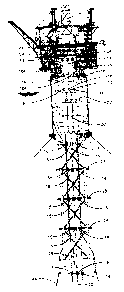Some of the information on this Web page has been provided by external sources. The Government of Canada is not responsible for the accuracy, reliability or currency of the information supplied by external sources. Users wishing to rely upon this information should consult directly with the source of the information. Content provided by external sources is not subject to official languages, privacy and accessibility requirements.
Any discrepancies in the text and image of the Claims and Abstract are due to differing posting times. Text of the Claims and Abstract are posted:
| (12) Patent Application: | (11) CA 2439788 |
|---|---|
| (54) English Title: | COMPLIANT STEM BUOYANCY CAN AND GUIDE |
| (54) French Title: | BOUEE PLATE ET GUIDE DE FLOTTABILITE MASSIFS SOUPLES |
| Status: | Deemed Abandoned and Beyond the Period of Reinstatement - Pending Response to Notice of Disregarded Communication |
| (51) International Patent Classification (IPC): |
|
|---|---|
| (72) Inventors : |
|
| (73) Owners : |
|
| (71) Applicants : |
|
| (74) Agent: | SMART & BIGGAR LP |
| (74) Associate agent: | |
| (45) Issued: | |
| (22) Filed Date: | 2003-09-08 |
| (41) Open to Public Inspection: | 2004-03-11 |
| Examination requested: | 2003-09-08 |
| Availability of licence: | N/A |
| Dedicated to the Public: | N/A |
| (25) Language of filing: | English |
| Patent Cooperation Treaty (PCT): | No |
|---|
| (30) Application Priority Data: | ||||||
|---|---|---|---|---|---|---|
|
A compliant stem buoyancy can and guide for a floating
offshore structure or vessel. The buoyancy can is supported at
the upper stop and the various heave plates by a slip ring that
allows axial displacement but constrains any radial motion.
The buoyancy can behaves as a complaint beam with a dynamic
response like a spring/mass/damper. The stiffness and mass
acts to govern the amplitude and frequency of the motion. The
water in the well bay reacts to the relative speed of the
vessel motion and the buoyancy can. The water thus acts as a
damper. The vessel, stem, and buoyancy can are designed so the
clearance between the buoyancy can and hull is larger than the
maximum amplitude of the oscillation. Therefore, the can will
not impact the hull. The kinetic energy is dissipated by the
compliant response of the buoyancy can and stem structure.
Because the buoyancy can never hits the hull there are no
impact loads or fatigue associated with impacts.
Note: Claims are shown in the official language in which they were submitted.
Note: Descriptions are shown in the official language in which they were submitted.

2024-08-01:As part of the Next Generation Patents (NGP) transition, the Canadian Patents Database (CPD) now contains a more detailed Event History, which replicates the Event Log of our new back-office solution.
Please note that "Inactive:" events refers to events no longer in use in our new back-office solution.
For a clearer understanding of the status of the application/patent presented on this page, the site Disclaimer , as well as the definitions for Patent , Event History , Maintenance Fee and Payment History should be consulted.
| Description | Date |
|---|---|
| Time Limit for Reversal Expired | 2007-09-10 |
| Application Not Reinstated by Deadline | 2007-09-10 |
| Inactive: Abandoned - No reply to s.30(2) Rules requisition | 2006-11-23 |
| Inactive: Abandoned - No reply to s.29 Rules requisition | 2006-11-23 |
| Deemed Abandoned - Failure to Respond to Maintenance Fee Notice | 2006-09-08 |
| Inactive: S.30(2) Rules - Examiner requisition | 2006-05-23 |
| Inactive: S.29 Rules - Examiner requisition | 2006-05-23 |
| Inactive: IPC from MCD | 2006-03-12 |
| Inactive: IPC from MCD | 2006-03-12 |
| Amendment Received - Voluntary Amendment | 2005-12-28 |
| Inactive: S.30(2) Rules - Examiner requisition | 2005-08-23 |
| Application Published (Open to Public Inspection) | 2004-03-11 |
| Inactive: Cover page published | 2004-03-10 |
| Amendment Received - Voluntary Amendment | 2003-11-04 |
| Inactive: IPC assigned | 2003-10-29 |
| Inactive: IPC assigned | 2003-10-29 |
| Inactive: First IPC assigned | 2003-10-29 |
| Letter Sent | 2003-10-02 |
| Filing Requirements Determined Compliant | 2003-10-02 |
| Inactive: Filing certificate - RFE (English) | 2003-10-02 |
| Letter Sent | 2003-09-30 |
| Application Received - Regular National | 2003-09-30 |
| Request for Examination Requirements Determined Compliant | 2003-09-08 |
| All Requirements for Examination Determined Compliant | 2003-09-08 |
| Abandonment Date | Reason | Reinstatement Date |
|---|---|---|
| 2006-09-08 |
The last payment was received on 2005-08-18
Note : If the full payment has not been received on or before the date indicated, a further fee may be required which may be one of the following
Please refer to the CIPO Patent Fees web page to see all current fee amounts.
| Fee Type | Anniversary Year | Due Date | Paid Date |
|---|---|---|---|
| Request for examination - standard | 2003-09-08 | ||
| Application fee - standard | 2003-09-08 | ||
| Registration of a document | 2003-09-08 | ||
| MF (application, 2nd anniv.) - standard | 02 | 2005-09-08 | 2005-08-18 |
Note: Records showing the ownership history in alphabetical order.
| Current Owners on Record |
|---|
| MENTOR SUBSEA TECHNOLOGY SERVICES, INC. |
| Past Owners on Record |
|---|
| AMEDEO MARCOTULLI |